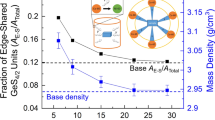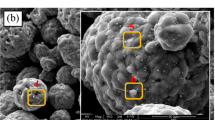Abstract
Rare earth elements (RRE), due to their unique magnetic, electrical, and optical properties, are an important group of elements demanded in many application areas from machine technology to the health industry. In this study, new composites were obtained by mixing Erbium oxide (Er2O3), one of the rare earth element oxides, into PCL–PEG blend, which is also an important material group, in different ratios. The characteristic functional groups of the obtained polymer blend/Er2O3 nanocomposites were determined by the ATR-IR, and as the erbium oxide ratio increased, characteristic peaks of the polymers in the blend as well as characteristic signals of the Er–O–Er bond were found. When the thermal behavior of the obtained composites was examined, it was observed that the polymer blend exhibited miscible blend properties and the melting temperature of the polymer blend increased as the Er2O3 ratio increased. In addition, it was determined that the thermal stability of the composite increased significantly. X-ray measurements of composites at room temperature support other measurement results. It was determined that the presence of Er-RRE oxide increased the crystal structure feature in the polymer blend composite. Gamma radiation shielding capabilities of polymer materials containing different erbium ratios were investigated by calculating shielding parameters such as half value layer (HVL), radiation protection efficiency (RPE), and mean free path (MFP). Cs-137 and Co-60 radioactive sources were used as gamma sources. According to the obtained measurement results, Erbium oxide increased the absorption property of the polymer composite material.
Graphical abstract











Similar content being viewed by others
References
Bahl S, Nagar H, Singh I, Sehgal S (2020) Smart materials types, properties and applications: a review. Mater Today: Proc 28:1302–1306
Bogue R (2014) Smart materials: a review of capabilities and applications. Assem Autom 34:16–22
Pilate F, Toncheva A, Dubois P, Raquez J-M (2016) Shape-memory polymers for multiple applications in the materials world. Eur Polym J 80:268–294
Wieszczycka K, Staszak K, Woźniak-Budych MJ, Litowczenko J, Maciejewska BM, Jurga S (2021) Surface functionalization–The way for advanced applications of smart materials. Coord Chem Rev 436:213846
Behl M, Lendlein A (2007) Shape-memory polymers. Mater Today 10(4):20–28
Oliveira J, Correia V, Castro H, Martins P, Lanceros-Mendez S (2018) Polymer-based smart materials by printing technologies: improving application and integration. Addit Manuf 21:269–283
Qian Zhao H, Qi J, Xie T (2015) Recent progress in shape memory polymer: New behavior, enabling materials, and mechanistic understanding. Prog Polym Sci 49:79–120
Meng H, Li G (2013) A review of stimuli-responsive shape memory polymer composites. Polymer 54(9):2199–2221
Davis KA, Burke KA, Mather PT, Henderson JH (2011) Dynamic cell behavior on shape memory polymer substrates. Biomaterials 32(9):2285–2293
Haibao Lu, Kai Yu, Sun S, Liu Y, Leng J (2010) Mechanical and shape-memory behavior of shape-memory polymer composites with hybrid fillers. Polym Int 59(6):766–771
Turner A, Scott JW, Green LA (2021) Rare earth elements in plastics. Sci Total Environ 774:145405
Jowitt SM, Werner TT, Weng Z, Mudd GM (2018) Recycling of the rare earth elements. Curr Opin Green Sustain Chem 13:1–7
Balaram V (2019) Rare earth elements: a review of applications, occurrence, exploration, analysis, recycling, and environmental impact. Geosci Front 10(4):1285–1303
Klinger JM (2018) Rare earth elements: development, sustainability and policy issues. Extr Ind Soc 5(1):1–7
Mostafa MYA, Zakaly HMH, Issa SAM, Saudia HA, Henaish AMA (2022) Tailoring variations in the linear optical and radiation shielding parameters of PVA polymeric composite films doped with rare-earth elements. Appl Phys A 128(3):1–14
Hamdalla TA, Hanafy TA, Bekheet AE (2015) Influence of erbium ions on the optical and structural properties of polyvinyl alcohol. J Spectrosc. https://doi.org/10.1155/2015/204867
Barimah EK, Rahayu S, Ziarko MW, Bamiedakis N, White IH, Penty RV, Kale GM, Jose G (2020) Erbium-doped nanoparticle–polymer composite thin films for photonic applications: structural and optical properties. ACS Omega 5(16):9224–9232
Chandra S, Gruber JB, Burdick GW, Sardar DK (2011) Fabrication and absorption intensity analyses of Er2O3 nanoparticles suspended in polymethyl methacrylate. J Appl Polym Sci 122(1):289–295
El Askary A, El-Sharnouby M, Awwad NS, Ibrahium HA, El-Morsy MA, Farea MO, Menazea AA (2022) Optical, thermal, and electrical conductivity strength of ternary CMC/PVA/Er2O3 NPs nanocomposite fabricated via pulsed laser ablation. Physica B 637:413910
Alshammari AH, Alshammari M, Ibrahim M, Alshammari K, Taha TAM (2023) New hybrid PVC/PVP polymer blend modified with Er2O3 nanoparticles for optoelectronic applications. Polymers 15(3):684
Kadham AJ, Hassan D, Mohammad N, Ah-yasari AH (2018) Fabrication of (polymer blend-magnesium oxide) nanoparticle and studying their optical properties for optoelectronic applications. Bull Electr Eng Inf 7(1):28–34
Chieng BW, Ibrahim NA, Zin WM, Yunus W, Hussein MZ (2013) Poly (lactic acid)/poly (ethylene glycol) polymer nanocomposites: effects of graphene nanoplatelets. Polymers 6(1):93–104
Yilmaz M, Pekdemir ME, Öner EÖ (2023) Evaluation of Pb doped Poly (lactic acid)(PLA)/Poly (ethylene glycol)(PEG) blend composites regarding physicochemical and radiation shielding properties. Radiat Phys Chem 202:110509
Pekdemir S, Öner EÖ, Pekdemir ME, Dalkılıç S, Dalkılıç LK (2022) An investigation into the influence of C. moschata leaves extract on physicochemical and biological properties of biodegradable PCL/PLA blend film. J Polym Environ 30(9):3645–3655
Pekdemİr ME (2022) Thermal properties and shape memory behavior of titanium carbide reinforced poly (vinyl chloride)/poly (ε-caprolactone) blend nanocomposites. Polym-Plast Technol Mater 61(3):242–250
Pekdemir ME (2021) Synthesis, characterization and thermal behavior of carbon fiber reinforced poly (vinyl chloride) and poly (ε-Caprolactone). Fibers Polym 22(10):2861–2868
Vrandečić NS, Erceg M, Jakić M, Klarić I (2010) Kinetic analysis of thermal degradation of poly (ethylene glycol) and poly (ethylene oxide) s of different molecular weight. Thermochim Acta 498(1–2):71–80
Azad F, Maqsood A (2014) Fabrication, structural characterization, dielectric and electrical parameters of the synthesized nano-crystalline erbium oxide. Electron Mater Lett 10(3):557–563
Nyquist RA, Kagel RO (2012) Handbook of infrared and raman spectra of inorganic compounds and organic salts: infrared spectra of inorganic compounds. Academic press, Cambridge
Runshen Xu, Tao Q, Yang Yi, Takoudis CG (2012) Atomic layer deposition and characterization of stoichiometric erbium oxide thin dielectrics on Si (100) using (CpMe) 3Er precursor and ozone. Appl Surf Sci 258(22):8514–8520
Öner EÖ, Pekdemir ME, Ercan E, Say Y, Kök M, Aydoğdu Y (2022) Novel of (PLA/PCL blend)/Gd2O3 rare earth oxide nanocomposites: shape memory effect, thermal, magnetic, and mechanical properties. Polym Compos 43(5):3096–3103
Yang C-C, Lee Y-J, Yang JM (2009) Direct methanol fuel cell (DMFC) based on PVA/MMT composite polymer membranes. J Power Sour 188(1):30–37
Loh XJ, Sng KBC, Li J (2008) Synthesis and water-swelling of thermo-responsive poly (ester urethane) s containing poly (ε-caprolactone), poly (ethylene glycol) and poly (propylene glycol). Biomaterials 29(22):3185–3194
Lee KH, Kim HY, Khil MS, Ra YM, Lee DR (2003) Characterization of nano-structured poly (ε-caprolactone) nonwoven mats via electrospinning. Polymer 44(4):1287–1294
Pekdemir ME, Kök M, Qader IN, Yıldırım A (2022) Preparation and physicochemical properties of mwcnt doped polyvinyl chloride/poly (ε-caprolactone) blend. J Polym Res 29(4):1–9
Levchuk D, Levchuk S, Maier H, Bolt H, Suzuki A (2007) Erbium oxide as a new promising tritium permeation barrier. J Nucl Mater 367:1033–1037
Mohammadi A, Badraghi J, Moghaddam AB, Ganjkhanlou Y, Kazemzad M, Hosseini S, Dinarvand R (2011) Synthesis of Er2O3 nanoparticles and Er2O3 nanoparticle/polyaniline deposition on the surface of stainless steel by potentiostatic deposition. Chem Eng Technol 34(1):56–60
Rajaji U, Manavalan S, Chen S-M, Chinnapaiyan S, Tse-Wei Chen R, Ramalingam J (2019) Facile synthesis and characterization of erbium oxide (Er2O3) nanospheres embellished on reduced graphene oxide nanomatrix for trace-level detection of a hazardous pollutant causing methemoglobinaemia. Ultrason Sonochem 56:422–429
Mohanapriya MK, Deshmukh K, Ahamed MB, Chidambaram K, Pasha SK (2016) Influence of cerium oxide (CeO2) nanoparticles on the structural, morphological, mechanical and dielectric properties of PVA/PPy blend nanocomposites. Mater Today: Proc 3(6):1864–1873
Roy S, Das D, Roy TK (2017) Processing, characterization and properties of Er 2 O 3 added ZnO based varistor ceramics. J Mater Sci: Mater Electron 28:14906–14918
Lai G-Q, Liu H-Z, Chen B-D, Niu D, Lei B, Jiang W-T (2020) Electrodeposition of functionally graded Ni-W/Er2O3 rare earth nanoparticle composite film. Int J Miner Metall Mater 27:818–829
AbuAlRoos NJ, Azman MN, Amin NAB, Zainon R (2020) Tungsten-based material as promising new lead-free gamma radiation shielding material in nuclear medicine. Physica Med 78:48–57
Olukotun SF, Gbenu ST, Ibitoye FI, Oladejo OF, Shittu HO, Fasasi MK, Balogun FA (2018) Investigation of gamma radiation shielding capability of two clay materials. Nucl Eng Technol 50(6):957–962
Singh J, Singh H, Sharma J, Singh T, Singh PS (2018) Fusible alloys: a potential candidate for gamma rays shield design. Prog Nucl Energy 106:387–395
Aygün B (2020) High alloyed new stainless steel shielding material for gamma and fast neutron radiation. Nucl Eng Technol 52(3):647–653
Reda SM, Saleh HM (2021) Calculation of the gamma radiation shielding efficiency of cement-bitumen portable container using MCNPX code. Prog Nucl Energy 142:104012
Medhat MEB (2012) Application of gamma-ray transmission method for study the properties of cultivated soil. Ann Nucl Energy 40(1):53–59
Kharita MH, Takeyeddin M, Alnassar M, Yousef S (2008) Development of special radiation shielding concretes using natural local materials and evaluation of their shielding characteristics. Prog Nucl Energy 50(1):33–36
Singh N, Singh KJ, Singh K, Singh H (2004) Comparative study of lead borate and bismuth lead borate glass systems as gamma-radiation shielding materials. Nucl Instrum Methods Phys Res, Sect B 225(3):305–309
Niksarlıoğlu S, Akman F, Pekdemir ME, Kuzu SY, Kaçal MR, Yılmaz M (2023) An extensive investigation on gamma shielding properties of PLA/Gd2O3 nanocomposites. Radiat Phys Chem 208:110936
Sayyed MI, Tekin HO, Kılıcoglu O, Agar O, Zaid MHM (2018) Shielding features of concrete types containing sepiolite mineral: comprehensive study on experimental, XCOM and MCNPX results. Res phys 11:40–45
Kaur T, Sharma J, Singh T (2017) Feasibility of Pb-Zn binary alloys as gamma rays shielding materials. Int J Pure Appl Phys 13(1):222–225
Acknowledgements
This work was supported by the Management Unit of the Scientific Research Projects of Fırat University (FUBAP) (Project Numbers: FF.22.10 and FF.23.01).
Author information
Authors and Affiliations
Corresponding author
Ethics declarations
Conflict of interest
The authors declare that they have no known competing financial interests or personal relationships that could have appeared to influence the work reported in this paper.
Additional information
Publisher's Note
Springer Nature remains neutral with regard to jurisdictional claims in published maps and institutional affiliations.
Rights and permissions
Springer Nature or its licensor (e.g. a society or other partner) holds exclusive rights to this article under a publishing agreement with the author(s) or other rightsholder(s); author self-archiving of the accepted manuscript version of this article is solely governed by the terms of such publishing agreement and applicable law.
About this article
Cite this article
Taşgin, Y., Pekdemir, M.E., Yilmaz, M. et al. Physical and shielding properties of Er2O3 rare earth oxide compound content on PCL/PEG blend. Polym. Bull. 81, 2915–2931 (2024). https://doi.org/10.1007/s00289-023-04818-1
Received:
Revised:
Accepted:
Published:
Issue Date:
DOI: https://doi.org/10.1007/s00289-023-04818-1




